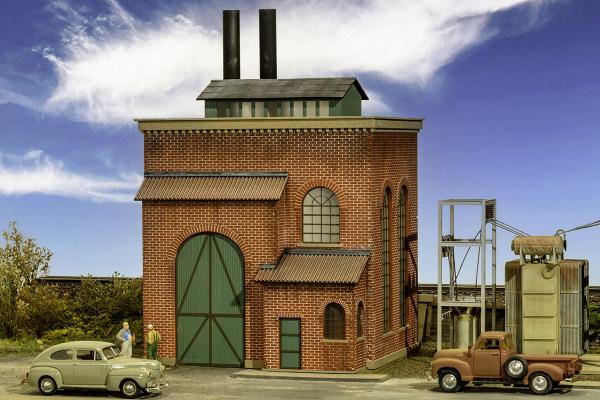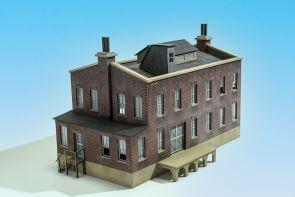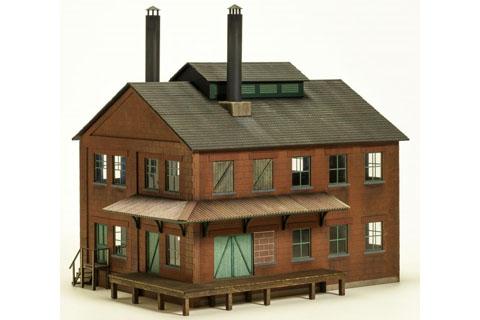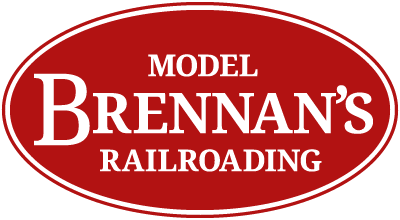BMRR Blog

Garfield Electric Substation
Introducing the first kit in my Dennis Brennan Signature Series. The Garfield Electric Substation—a brand-new, original O-scale laser-cut kit that brings historically correct realism to your layout. Other Garfield City structures are being developed. Whether tucked into a cityscape or powering up a remote rural scene, the Garfield Electric Substation is the perfect addition to elevating the realism and operational storytelling of your railroad.

Sanky Wanky Coffee Co.
Introducing the 4th kit in my highly popular Frank Ellison Tribute Series: The Sanky Wanky Coffee Co. Recreating these iconic structures have given me an even greater appreciation for what he had accomplished. Ellison’s buildings are perfectly proportioned. Many of his structures were based upon actual buildings that he selectively compressed. And that, my fellow modelers, is an art.

Richmond Packing Co.
The Richmond Packing Co. is the 3rd kit in in my Frank Ellison Tribute Series. The footprint is10-1/8 x 12-1/2 which includes the freight dock.
Frank Ellison was a pioneer model railroader back in the 1930s, 40s & 50s. He was considered a top name in the field and his beautifully built Delta Lines was perhaps the most widely known model railroad in the world according to John Page, the editor of Model Railroader Magazine in the early 1950s.

The Hap Hazard Packing Co.
This is the 2nd structure in my Frank Ellison Tribute Series. The kits are available. If you would like to have one of these limited edition kits, please contact me. The overall footprint is 10 x 17 including the shed and the loading platform. (The building's walls measure 6 x 17. The dock is 1.5" deep and the shed is 2.5" deep)
Completely detailed and photographically illustrated instructions show even a beginner how to build, weather and paint this kit. $149.95

Dennis Brennan Recognized as one of the Top Model Railroad Photographers by Classic Toy Trains Magazine
I was recognized by Classic Toy Trains magazine in the December 2017 issue as one of the top model railroad photographers over the past 30 years. This is in the December issue!
"Let’s turn the spotlight on a different group of photographers, free-lancers hired for specific assignments... More often our free-lancers came from outside, having built solid reputations in the fields of railroad photography and scale modeling"
"Three stand out for the consistently high quality of their work. Dennis Brennan, Steve Crise, and Paul Dolkos have long added to CTT by providing terrific images. We look forward to many more years of collaboration with them."

Introducing the Ob Long Box Co
This is the prototype for the Ob Long Box Co.--the first kit in my Frank Ellison Tribute Series. Frank was a model railroad pioneer back in the 1930s, 40s & 50s. He was considered a top name in the field and his beautifully built Delta Lines was perhaps the most widely known model railroad in the world according to John Page, the editor of Model Railroader Magazine in the early 1950s.

Structure Placement and Scenic Details
Using my prototype for the Oblong Box Co. kit, I’m going to show you how to integrate a rail side structure into your layout. Placement is important when you have rolling stock clearances to take into account, especially when a spur track actually enters a factory. I use the National Model Railroad Association (NMRA) Standard Clearances as a guide for locating the track relative to a loading platform—in this case our interior loading dock wall:

Roundhouse Kit
This is a Limited Edition Plaster Roundhouse Kit. I have produced 60 kits and there are less than 8 left. Because each kit may be ordered with different options, please allow up to 5 weeks for delivery. This allows time for ordering the laser cut windows and the custom packaging for your kit. If you have any questions, please call or email.
This roundhouse is inspired by the Norfolk & Western Ry. Roundhouse in Williamson, WV. The more-than-a-century-old prototype has a traveling overhead crane that traverses the open two story center section. It also uses roll up overhead corrugated steel roller doors. And, in case you’re wondering, I’ve discovered that roller doors came into existence sometime prior to 1925.

0 Scale or O Scale, 0 Gauge or O gauge?—That is the question.
First let’s look at words scale and gauge. Although they’re often used interchangeably, they refer to two different albeit related things. Scale is the proportion to life size expressed as a ratio: 1/48 or 1:48 for O Scale or ¼ inch = 1 foot.
Strictly speaking, gauge properly refers to the distance between the rails. So in O Scale, the track gauge would be 1-1/4 inches. That equates to 5 scale feet, although in real life the distance is actually 4 feet 8-1/2 inches between rails. This discrepancy is negligible and will be addressed in another post. Since each scale - O, S, HO, N, Z has its own proportionate gauge, it’s easy to understand why gauge is often substituted for and understood to mean scale.

Chain Link Fence Review by Eric's Trains
Pretty much since day one of planning my O-Scale layout, I’ve known that I would eventually want to add quite a few chain link fences to the scenery. Chain link fences are EVERYWHERE in modern times, so it only makes sense that a train layout would have quite a few of them to keep would-be trespassers out of a train yard, a power plant, a factory or any other are where privacy is desired. To that end, several years ago I bought a chain link fence kit from Brennan’s Model Railroading. Dennis Brennan has become a good friend over the years and his expertise in scenery building has proved invaluable to me. A great majority of my speciality scenic supplies (fences, ground cover, track ballast etc.) come from Dennis. His chain link fence kit, when assembled properly, results in the most realistic O-Scale chain link fence on the market…period.
